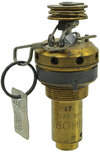In addition to the photographs in the link posted by
sgdbdr, these data may help you:
Side-Pocket Pistol No. 47 Mk I (Service)
Bombs used in: G.P. 4,000-lb. Mk I, H.C. 2,000-lb. Mk I, and H.C. 4,000-lb. Mks I and II
Action: Chemical long delay of ½ hr.
Armed condition: When the arming screw is down, or when the pistol has been dropped
Fuzes used with: Nose Pistols No. 27, 42, or 44; Tail Pistols No. 28, 30, or 37
Body diameter: 2.0 in.
Over-all length: 4.5 in.
Color: Brass body with steel arming screw
Description:
This pistol is of the chemical long-delay type used in the side pocket of the above-mentioned bombs.
Extending out of the brass body is a steel arming screw.
At the top of the arming screw is fastened a brass or steel pulley, around which is wrapped a phosphor-bronze wire. This wire is secured to the pulley, runs out through a guide key, and is soldered to the safety clip, which is located between the pulley and the head of the pistol.
The safety pin passes through the arms of the safety clip, preventing the latter from being removed accidentally.
Below the arming screw is an ampoule of acetone, which is scaled in by a rubber washer above it.
Below the acetone ampoule is a zinc sea-ting disc, which acts as a knife edge to break the ampoule, and a celluloid disc, which holds up the spring loaded striker and its retaining balls.
Operation: When the bomb is put in the plane, the safety pin is removed. Upon re-lease, the safety clip is pulled out, and the wire, which is attached to it and also around the pulley, is reeled off the pulley. This screws the arming screw down into the acetone ampoule, breaking it and allowing the acetone to run out onto the celluloid disc. When the celluloid has become softened the force of the compressed firing spring cams the re-lease balls out, and forces the striker against the detonator.
Remarks: This pistol has a ½-hour delay, and has no anti-withdrawal device incorporated in it.







